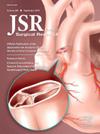在腹腔镜胆囊切除术中,外科医生对其安全性评价的准确性有多高?
IF 1.8
3区 医学
Q2 SURGERY
引用次数: 0
摘要
在腹腔镜胆囊切除术(LC)中,获得安全关键视图(CVS)被认为是减少胆管损伤的重要步骤。然而,现有文献表明,当LC视频由专家直接评估时,很少有外科医生获得足够的CVS。这种差异需要有效、规范的CVS教学方法。虽然自我评估(SA)仍然是执业外科医生用于提高表现的主要工具,但其有效性存在争议。本研究的目的是比较外科医生的重复LC表现和CVS的实现与专家评分者的效果。方法:对自愿参加的美国胃肠和内窥镜外科医生协会的外科医生成员进行多机构研究。所有外科医生被要求提交LC视频并使用Strasberg量表完成CVS质量SA(0-6分,≥5分表示合适的CVS)。同样的视频由两名盲法评估专家进行了评估,他们是美国胃肠和内窥镜外科医生协会安全胆囊切除术工作组的成员,他们之前接受过评估培训。采用Wilcoxon sign -rank检验比较外科医生自我评分和专家评分。结果:招募了25名外科医生参与者,其中13人提交了LC视频。外科医生在第一次提交的基于专家评分的视频中没有达到足够的CVS。SA组的外科医生在手术表现评分系统(z = -0.36, P = 0.715)、腹腔镜整体手术技能评估(z = -0.37, P = 0.712)、Strasberg (z = -1.84, P = 0.066)和能力评估工具(z = -0.73, P = 0.465)四个量表上都高估了自己的表现。教练组的外科医生也高估了他们在每个量表上的表现:手术表现评分系统(z = -0.67, P = 0.500),腹腔镜手术技能总体评估(z = -1.48, P = 0.138), Strasberg (z = -1.07, P = 0.285)和能力评估工具(z = -1.21, P = 0.225)。结论:我们的研究证实,在一个小但全国性的普通外科医生样本中,LC期间很少获得足够的CVS。它进一步补充了现有的文献,表明仅SA可能不足以提高绩效。需要有效的教学方法,如专家或人工智能指导,以提高外科医生对适当CVS的使用,这可能有助于降低胆管损伤风险。本文章由计算机程序翻译,如有差异,请以英文原文为准。
How Accurate Are Surgeons at Assessing the Quality of Their Critical View of Safety During Laparoscopic Cholecystectomy?
Introduction
Obtaining the critical view of safety (CVS) is considered an important step to reduce bile duct injuries during laparoscopic cholecystectomy (LC). However, existing literature suggests that few surgeons obtain adequate CVS when LC videos are directly evaluated by experts. This discrepancy calls for effective, standardized CVS teaching methods. While self-assessment (SA) remains the principal tool utilized by practicing surgeons for performance improvement, its effectiveness is controversial. The aim of this study was to compare surgeon SAs of repeated LC performance and attainment of the CVS with that of expert raters.
Methods
Multi-institutional study of surgeon members from the Society of American Gastrointestinal and Endoscopic Surgeons who volunteered to participate. All surgeons were asked to submit an LC video and complete a SA of the CVS quality using the Strasberg scale (0-6 score with ≥5 score indicating appropriate CVS). The same videos were reviewed by two blinded expert raters, members of the Society of American Gastrointestinal and Endoscopic Surgeons safe cholecystectomy task force, who had received prior rater training. Surgeon self-ratings and expert ratings were compared with a Wilcoxon signed-rank test.
Results
Twenty-five surgeon-participants were recruited, 13 of whom submitted an LC video. Surgeons did not achieve adequate CVS in their first submitted video based on expert ratings. Surgeons in the SA group overestimated their performance across all four scales: Operative Performance Rating System (z = −0.36, P = 0.715), Global Operative Assessment of Laparoscopic Skills (z = −0.37, P = 0.712), Strasberg (z = −1.84, P = 0.066), and Competency Assessment Tool (z = −0.73, P = 0.465). Surgeons in the coaching group overestimated their performance on each scale as well: Operative Performance Rating System (z = −0.67, P = 0.500), Global Operative Assessment of Laparoscopic Skills (z = −1.48, P = 0.138), Strasberg (z = −1.07, P = 0.285), and Competency Assessment Tool (z = −1.21, P = 0.225).
Conclusions
Our study confirms that an adequate CVS is infrequently obtained during LC in a small but national sample of general surgeons. It further adds to the existing body of literature that suggests that SA alone may be inadequate for performance improvement. Effective teaching methods such as expert or artificial intelligence coaching are needed to improve the use of appropriate CVS by surgeons that may help decrease bile duct injury risk.
求助全文
通过发布文献求助,成功后即可免费获取论文全文。
去求助
来源期刊
CiteScore
3.90
自引率
4.50%
发文量
627
审稿时长
138 days
期刊介绍:
The Journal of Surgical Research: Clinical and Laboratory Investigation publishes original articles concerned with clinical and laboratory investigations relevant to surgical practice and teaching. The journal emphasizes reports of clinical investigations or fundamental research bearing directly on surgical management that will be of general interest to a broad range of surgeons and surgical researchers. The articles presented need not have been the products of surgeons or of surgical laboratories.
The Journal of Surgical Research also features review articles and special articles relating to educational, research, or social issues of interest to the academic surgical community.

 求助内容:
求助内容: 应助结果提醒方式:
应助结果提醒方式:


